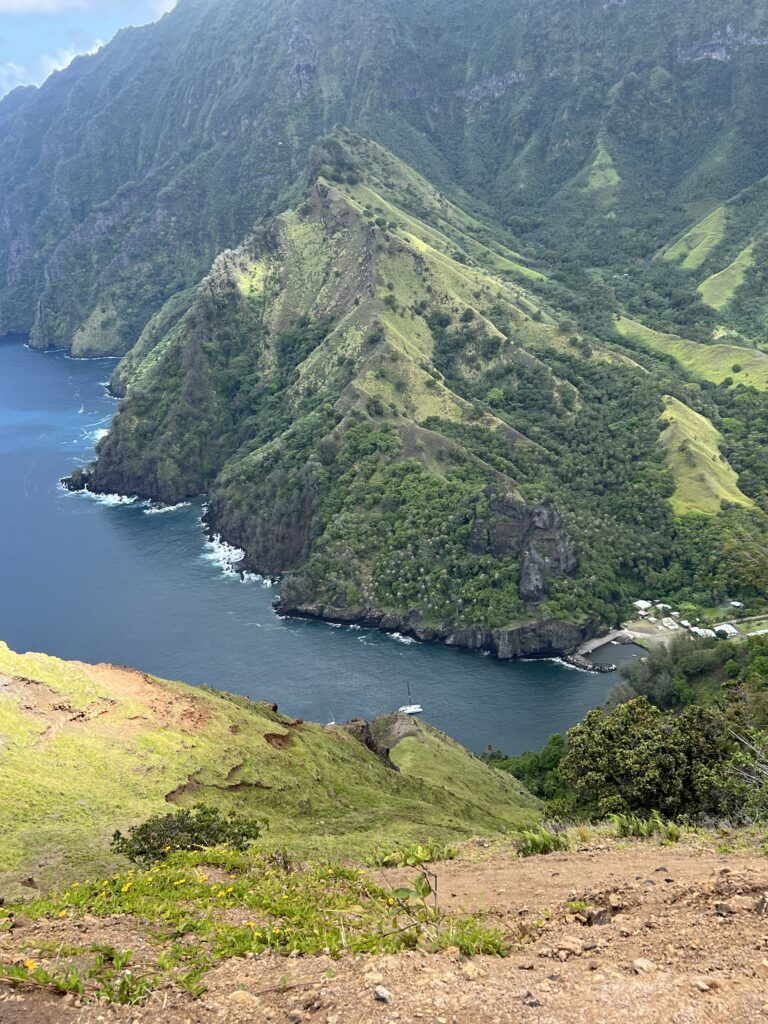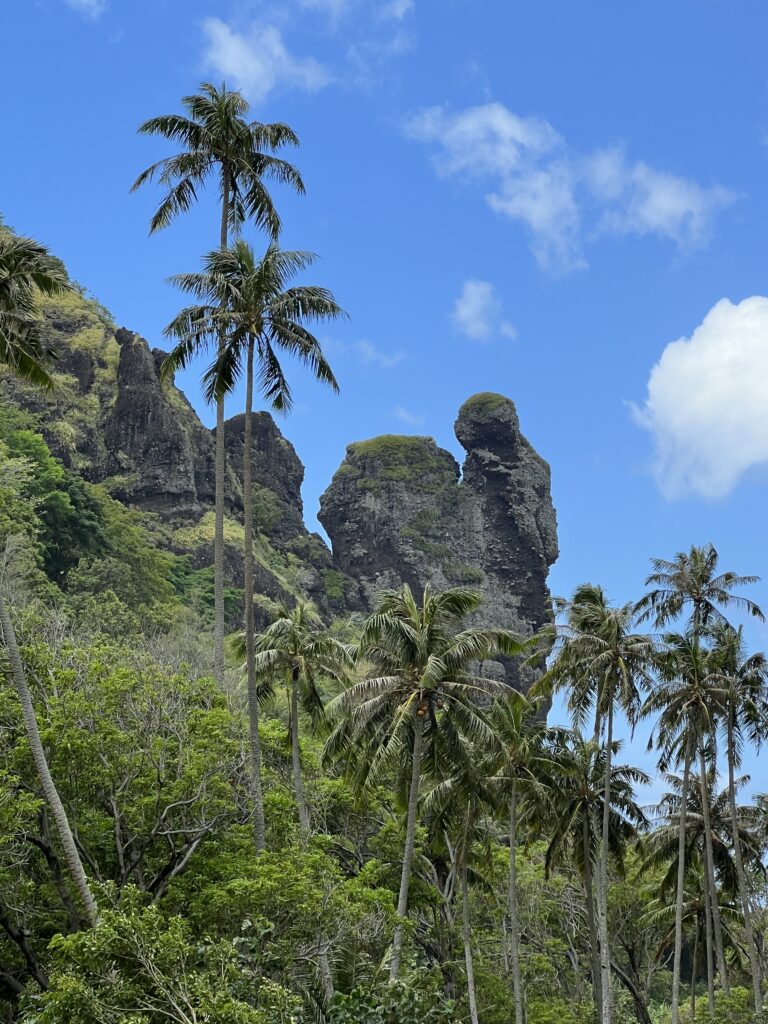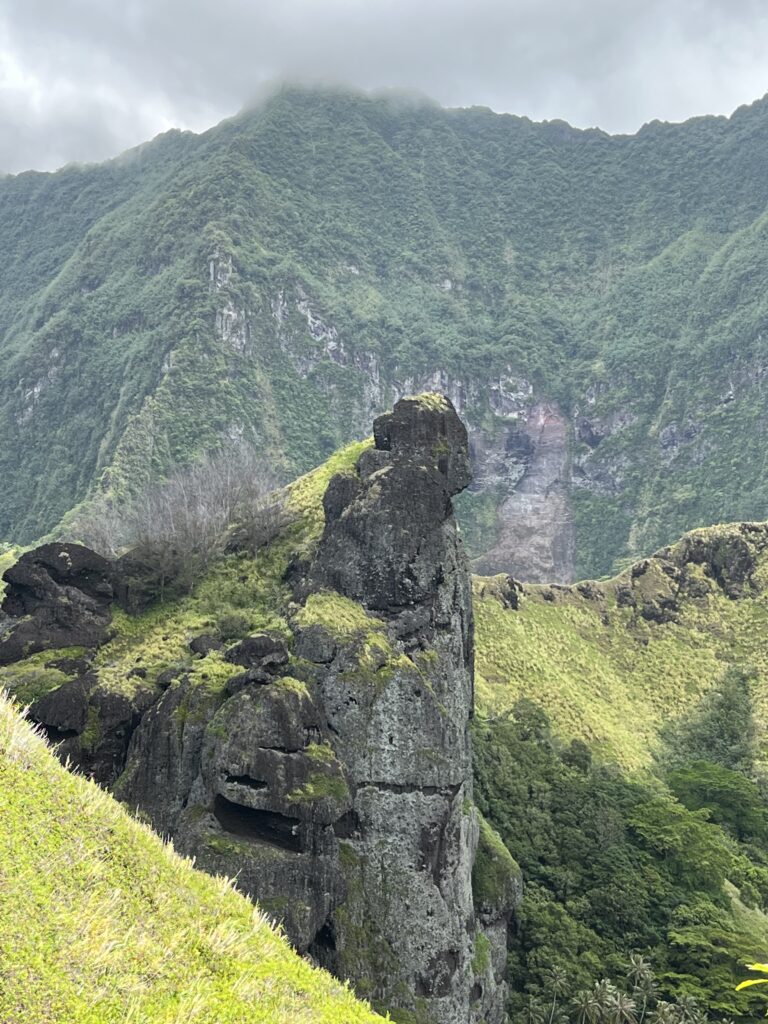Posted March 12, 2023 from Tahiti. See new YouTube on Fatu Hiva.

During our year in French Polynesia I really wanted to see Fatu Hiva, reputed to the most dramatically beautiful mountain scenery in all French Polynesia. In December the prevailing winds are east and northeast, which means sailing northeast is difficult. On our trip to the Marquesas from Tahiti we passed west of Fatu Hiva on account of unfavorable winds and anchored in Taiohae Bay, Nuku Hiva. What a nice welcome to have fresh fruit and vegetable market right on the public wharf!
After Nuku Hiva we visited Tahuatu, a sparsely populated island with beautiful turquoise water and a white sand beach. In the Marquesas, most bays are muddy where mountains plunge to the sea into deep water. In Tahuatu, Hanamoena Bay is quite isolated with no nearby roads, and mountains separate the bay from the town. There we enjoyed a slower pace and enjoyed swimming and paddle boarding to the beach. The beach had a large surf, and setting off the beach with a dog on the paddle board was always challenging. To go back to the boat, I waded into the surf with a strong hold on the paddle board and the handle of Tiller’s life preserver to prevent the dog from being swept back to the beach with a crashing wave. Then I hoisted the dog aboard as the undertow from a wave started to withdraw the water, jumped on the board and paddled like crazy before the next wave arrived. A missed attempt meant a tumble to the beach and sandy bathing suit.
With a good weather window and we left Tahuatu for 5 hours sail to Fatu Hiva. We arrived at the end of the day under a light drizzle to cool the afternoon sun. I can unequivocally state that Fatu Hiva is truly the island with the most dramatically spectacular landscape as you sail into the anchorage. Pillars of rock reach to the sky with a backdrop of mountainous ridges. The rocky spires are set against emerald-green forests and lime-green shrubbery between vertical ridges.
In Fatu Hiva the main anchorage is The Bay of Virgins, or Baie de Vierges in French. This bay is named for the pinnacles of rock that surround the bay. It is rumored that the Bay was originally named Baie de Verges (Bay of Penises) but the missionaries latter added an “i” to the word verges to rename it Baie de Vierges. From the sea the rocks certainly do look like phallic statues.

We were lucky that there was only one other boat in the narrow bay lined with exposed rocks. Strong catabolic winds sweep down from the mountains sending the boat spinning around the anchor. We experienced gusts over 40 knots coming from different directions to swing the boat around. It is known that this bay can be treacherous, and with the weather conditions we had, the locals were not venturing out in their small boats.
With our hook down before sunset, we headed to the small wharf behind a breakwater. There was a large surf, just breaking at the entrance to the wharf. Timing and full motor speed were required to ensure the dinghy was not tossed upside down with a breaking wave. We used the wheels on our dinghy to take it up the boat ramp and store it ashore. The surge was too great to leave it tied to the dock.
I brought fishing tackle and lures to trade. I said hello to a young man fishing at the dock and showed him what I had brought to trade for fruit. I gave him the lures and he promised to return the following day. As we walked through town a couple hailed us and invited us into their home. Sobe and Leia showed us the “tikis” that they had carved and asked us to trade. These islanders are wise to the value of goods and know what to ask for – Sobe specifically asked for “repella” lures and Leia for lipstick and face creams. Their garden was lined with plentiful grapefruit trees. It was late in the day, and we wanted to get back to the boat before dark, so we promised to return the next day. They gave us grapefruit and bananas to take with us.
The following morning as we landed at the dinghy dock were immediately approached by another local man, Patrick, who offered to give us a lift to the highest point above the bay see the view. We had planned to hike but the day was already heating up, and we accepted the ride so that we could get a view from the very top. The road is the only path that extends to another small town at the far end of the island. It was a steep road with continuous hairpin turns and vertical drop offs on the ocean side. The safety rail on the ocean side stops just as the road turns to dirt past the shrine where Patrick stopped to pray. Patrick wanted to drive us all the way. But we told him we need to walk a bit, so we got out and hiked up the rest of the way. That last bit of road after the turn off to the radio tower had cliffs on BOTH sides!
The view was fabulous from every vantage point. And then the walk down. The road was so steep at points that we walked backwards!
Later that day we went back to Sobe and Leia’s house and they were delighted with the fishing lures and the package of creams and makeup that I brought. We were disappointed with the young man who had promised fruit. He gave us bananas but asked us to come back later for the rest that he had promised. We never managed to meet him again because the weather turned, the anchorage was rough, and going back to shore another time would not be easy. Also, needed to sail back to Nuku Hiva to meet up with friends that planned to fly in to meet us there. There is no airport in Fatu Hiva.
Fatu Hiva is the southernmost island in the Marquesan chain of islands and is missed by many cruisers arriving from Panama because there are no customs facilities to check into Polynesia. Sailing upwind to visit the island it is worth a rough passage! It was nice to be off-season, as we were, despite the windy conditions during our stay.

BEAUTIFUL Lisa
Quelles belles photos Lisa! Merci pour tout! xxx